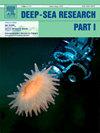北大西洋中纬度涡旋影响浮游动物丰度的纬向转变
IF 2.1
3区 地球科学
Q2 OCEANOGRAPHY
Deep-Sea Research Part I-Oceanographic Research Papers
Pub Date : 2025-10-17
DOI:10.1016/j.dsr.2025.104605
引用次数: 0
摘要
中尺度涡旋通过调节海洋环境从而影响海洋生物,在海洋生态系统中起着至关重要的作用。通过将连续浮游生物记录仪(CPR)项目的浮游动物观测数据与卫星获取的海表温度(SST)、叶绿素(Chl)浓度和基于海面高度的涡旋数据集相结合,研究了涡旋种群对北大西洋浮游动物群落丰度的影响。为了综合评价浮游动物群落的丰度和丰富度,我们引入了丰度指数作为统一的度量标准。北大西洋中纬度地区被划分为三个纬度区:南区(35°N - 45°N)、中区(45°N - 55°N)和北区(55°N - 70°N)。我们的分析显示,从1993年到2017年,三个区域的丰度指数有明显的年度变化。南区和北区气旋涡旋(CE)核的丰度指数均高于反气旋涡旋(AE)核,而中部则相反。然而,涡旋影响的Chl和SST的复合模式在所有区域是相似的。通过使用6个机器学习模型,我们评估了对数变换Chl (log-Chl)和海表温度在解释丰度指数中的特征重要性(FI)。研究发现,logchl比海温的影响更大,特别是在北部地区,这突出了相对于环境温度而言食物供应的重要性。1998年、2002年和2003年,南区、中区和北区的AE和CE岩心丰度指数差异发生了显著变化,表明最优生境可能因海洋气候变化而发生了变化。这些发现为中尺度涡旋对浮游动物群落的影响提供了更深入的见解,并强调了它们对海洋生态系统动力学的更广泛影响。本文章由计算机程序翻译,如有差异,请以英文原文为准。
Latitudinal transitions of eddy-affected zooplankton abundance in the mid-latitude North Atlantic
Mesoscale eddies play a critical role in marine ecosystems by regulating ocean environments and thereby influencing marine life. By integrating zooplankton observations from the Continuous Plankton Recorder (CPR) project with satellite-derived sea surface temperature (SST), chlorophyll (Chl) concentration, and eddy datasets based on sea surface height, we investigate the impacts of eddy populations on zooplankton community abundance in the North Atlantic. To comprehensively assess both the abundance and richness of zooplankton communities, we introduced the Abundance Index as a unifying metric. The mid-latitude North Atlantic is segmented into three latitudinal zones: the southern zone (35°N–45°N), the middle zone (45°N–55°N), and the northern zone (55°N–70°N). Our analysis revealed distinct annual variations in the Abundance Index across the three zones from 1993 to 2017. The Abundance Index was consistently higher within cyclonic eddy (CE) cores compared with anticyclonic eddy (AE) cores in the southern and northern zones, contrasting with the patterns in the middle zone. However, the composite patterns of eddy-affected Chl and SST were similar across all zones. By employing six machine learning models, we assessed the feature importance (FI) of log-transformed Chl (log-Chl) and SST in explaining the Abundance Index. Log-Chl was found to have a greater impact than SST, particularly in the northern zone, highlighting the greater importance of food availability relative to ambient temperature. Significant shifts in the Abundance Index differences between AE and CE cores were detected in 1998, 2002, and 2003 in the southern, middle, and northern zones, respectively, suggesting that optimal habitats may have shifted in response to ocean climate change. These findings provide deeper insights into the effects of mesoscale eddies on zooplankton communities and highlight their broader implications for marine ecosystem dynamics.
求助全文
通过发布文献求助,成功后即可免费获取论文全文。
去求助
来源期刊
CiteScore
4.60
自引率
4.20%
发文量
144
审稿时长
18.3 weeks
期刊介绍:
Deep-Sea Research Part I: Oceanographic Research Papers is devoted to the publication of the results of original scientific research, including theoretical work of evident oceanographic applicability; and the solution of instrumental or methodological problems with evidence of successful use. The journal is distinguished by its interdisciplinary nature and its breadth, covering the geological, physical, chemical and biological aspects of the ocean and its boundaries with the sea floor and the atmosphere. In addition to regular "Research Papers" and "Instruments and Methods" papers, briefer communications may be published as "Notes". Supplemental matter, such as extensive data tables or graphs and multimedia content, may be published as electronic appendices.

 求助内容:
求助内容: 应助结果提醒方式:
应助结果提醒方式:


